An Investigation on Design and Characterization of a Highly Selective LED Optical Sensor for Copper Ions in Aqueous Solutions
Abstract
1. Introduction
2. Materials and Methods
2.1. Preparation of Solutions
2.2. Optical Sensing Principle
2.3. Design and Setup of the Photoelectric Sensing System for Copper Ion Detection
2.4. Design of the Circuit
3. Results
3.1. Photometric Interpretion of Light Absorbance of Copper Ions in Aqueous Solution
3.2. Experimental Results of Photoelectric Sensing System
4. Conclusions
Author Contributions
Funding
Institutional Review Board Statement
Informed Consent Statement
Data Availability Statement
Conflicts of Interest
References
- Azadbakht, R.; Khanabadi, J. A novel fluorescent nano-chemosensor for Al (III) ions using a new macrocyclic receptor. Spectrochim Acta A Mol. Biomol. Spectrosc. 2014, 124, 249–255. [Google Scholar] [CrossRef] [PubMed]
- Wang, Z.X.; Ding, S.N. One-pot green synthesis of high quantum yield oxygen-doped, nitrogen-rich, photoluminescent polymer carbon nanoribbons as an effective fluorescent sensing platform for sensitive and selective detection of silver(I) and mercury(II) ions. Anal. Chem. 2014, 86, 7436–7445. [Google Scholar] [CrossRef]
- Saleem, M.; Rafiq, M.; Hanif, M.; Ashraf Shaheen, M.; Seo, S.-Y. A Brief Review on Fluorescent Copper Sensor Based on Conjugated Organic Dyes. J. Fluoresc. 2018, 28, 97–165. [Google Scholar] [CrossRef]
- Verma, R.; Gupta, B.D. Detection of heavy metal ions in contaminated water by surface plasmon resonance based optical fibre sensor using conducting polymer and chitosan. Food Chem. 2015, 166, 568–575. [Google Scholar] [CrossRef] [PubMed]
- Wang, S.Q.; Gao, Y.; Wang, H.Y.; Zheng, X.X.; Shen, S.L.; Zhang, Y.R.; Zhao, B.X. Synthesis X-ray crystal structure and optical properties of novel 1,3,5-triarylpyrazoline derivatives and the fluorescent sensor for Cu2+. Spectrochim Acta A. Mol. Biomol. Spectrosc. 2013, 106, 110–117. [Google Scholar] [CrossRef]
- Domaille, D.W.; Zeng, L.; Chang, C.J. Visualizing ascorbate-triggered release of labile copper within living cells using a ratiometric fluorescent sensor. J. Am. Chem. Soc. 2010, 132, 1194–1195. [Google Scholar] [CrossRef]
- Grasso, G.I.; Gentile, S.; Giuffrida, M.L.; Satriano, C.; Sgarlata, C.; Sgarzi, M.; Tomaselli, G.; Arena, G.; Prodi, L. Ratiometric fluorescence sensing and cellular imaging of Cu2+ by a new water soluble trehalose-naphthalimide based chemosensor. RSC. Adv. 2013, 3, 24288–24297. [Google Scholar] [CrossRef]
- Wang, J.; Li, H.; Long, L.; Xiao, G.; Xie, D. Fast responsive fluorescence turn-onsensor for Cu2+ and its application in live cell imaging. J. Lumin. 2012, 132, 2456–2461. [Google Scholar] [CrossRef]
- Dong, M.; Ma, T.H.; Zhang, A.J.; Dong, Y.M.; Wang, Y.W.; Peng, Y. A series of highly sensitive and selective fluorescent and colorimetric “off-on” chemosensors for Cu (II) based on rhodamine derivatives. Dyes Pigm. 2010, 87, 164–172. [Google Scholar] [CrossRef]
- Yu, M.; Yuan, R.; Shi, C.; Zhou, W.; Wei, L.; Li, Z. 1,8-Naphthyridine and 8-hydroxyquinoline modified rhodamine B derivatives: “turn-on” fluorescent and colorimetric sensors for Al3+ and Cu2+. Dyes Pigm. 2013, 99, 887–894. [Google Scholar] [CrossRef]
- Chen, X.; Jou, M.J.; Lee, H.; Kou, S.; Lim, J.; Nam, S.W.; Park, S.; Kim, K.M.; Yoon, J. New fluorescent and colorimetric chemosensors bearing rhodamine and binaphthyl groups for the detection of Cu2+. Sens. Actuators B Chem. 2009, 137, 597–602. [Google Scholar] [CrossRef]
- Lee, H.Y.; Swamy, K.M.K.; Jung, J.Y.; Kim, G.; Yoon, J. Rhodamine hydrazone derivatives based selective fluorescent and colorimetric chemodosimeters for Hg2+ and selective colorimetric chemosensor for Cu2+. Sens. Actuators B Chem. 2013, 182, 530–537. [Google Scholar] [CrossRef]
- Goswami, S.; Sen, D.; Das, A.K.; Das, N.K.; Aich, K.; Fun, H.K.; Quah, C.K.; Maity, A.K.; Sah, P. A new rhodamine-coumarin Cu2+-selective colorimetric and ‘off–on’ fluorescence probe for effective use in chemistry and bioimaging along with its bound X-ray crystal structure. Sens. Actuators B Chem. 2013, 183, 518–525. [Google Scholar] [CrossRef]
- Gao, W.; Yang, Y.; Huo, F.; Yin, C.; Xu, M.; Zhang, Y.; Chao, J.; Jin, S.; Zhang, S. An ICT colorimetric chemosensor and a non-ICT fluorescentchemosensor for the detection copper ion. Sens. Actuators B Chem. 2014, 193, 294–300. [Google Scholar] [CrossRef]
- Awual, M.R.; Hasan, M.M. Colorimetric detection and removal of copper (II) ions from wastewater samples using tailor-made composite adsorbent. Sensors Actuators B. 2014, 206, 692–700. [Google Scholar] [CrossRef]
- Gua, Y.; Wang, Z.; Qu, W.; Shao, H.; Jiang, X. Colorimetric detection of mercury, lead and copper ions simultaneously using protein-functionalized gold nanoparticles. Biosens. Bioelectron. 2011, 26, 4064–4069. [Google Scholar] [CrossRef] [PubMed]
- Ma, Y.; Niu, H.; Zhang, X.; Cai, Y. Colorimetric detection of copper ions in tap water during the synthesis of silver/dopamine nanoparticles. Chem. Commun. 2011, 47, 12643–12645. [Google Scholar] [CrossRef] [PubMed]
- Fang, B.; Liang, Y.; Chen, F. Highly sensitive and selective determination of cupricions by using N,N′-bis(salicylidene)-o-phenylenediamineas fluorescent chemosensor and relatedapplications. Talanta 2014, 119, 601–605. [Google Scholar] [CrossRef]
- Taillades, G.; Valls, O.; Bratov, A.; Dominguez, C.; Pradel, A.; Ribes, M. ISE and ISFET microsensors based on a sensitive chalcogenide glass for copper ion detection in solution. Sens. Actuators B 1999, 59, 123–127. [Google Scholar] [CrossRef]
- Debnath, R.; Das, S.K. Site-dependent luminescence of Cu+ ions in silica glass. Chem. Phys. Lett. 1989, 155, 52–58. [Google Scholar] [CrossRef]
- Cable, M.; Xiang, Z.D. Optical spectra of copper ions in alkali-lime-silica glasses. Phys. Chem. Glas. 1992, 33, 154–160. [Google Scholar]
- Barrie, J.D.; Dunn, B.; Gary, H.; Aink, J.I. Optical Spectroscopy of Copper (I)-doped Na+-betta. Alumina Phys. Chem. 1989, 93, 3958–3963. [Google Scholar] [CrossRef]
- Gonella, F. Characterization of Cu-Na ion-exchanged glass waveguides. Appl. Phys. Lett. 1996, 69, 314. [Google Scholar] [CrossRef]
- Srikumar, T.; Kityk, I.V.; Srinivasa Rao, C.; Gandhi, Y.; Piasecki, M.; Bragiel, P.; Ravi Kumar, V.; Veeraiaha, N. Photostimulated optical effects and some related features of CuO mixed Li2O– Nb2O5–ZrO2–SiO2 glass ceramics. Ceram. Int. 2011, 37, 2763–2779. [Google Scholar] [CrossRef]
- Febo, A.; Perrino, C. Evaluation of a High-Purity and High-Stability Continuous Generation System for Nitrous Acid. Atmos. Environ. 1991, 25A, 1055. [Google Scholar] [CrossRef]
- Goodman, A.L.; Underwood, G.M.; Grassian, V.H. Heterogeneous Reaction of NO2: Characterization of Gas-Phase and Adsorbed Products from the Reaction, 2NO2(g)+H2O→HONO(g)+HNO3(a) on Hydrated Silica Particles. J. Phys. Chem. A 1999, 103, 7217–7223. [Google Scholar] [CrossRef]
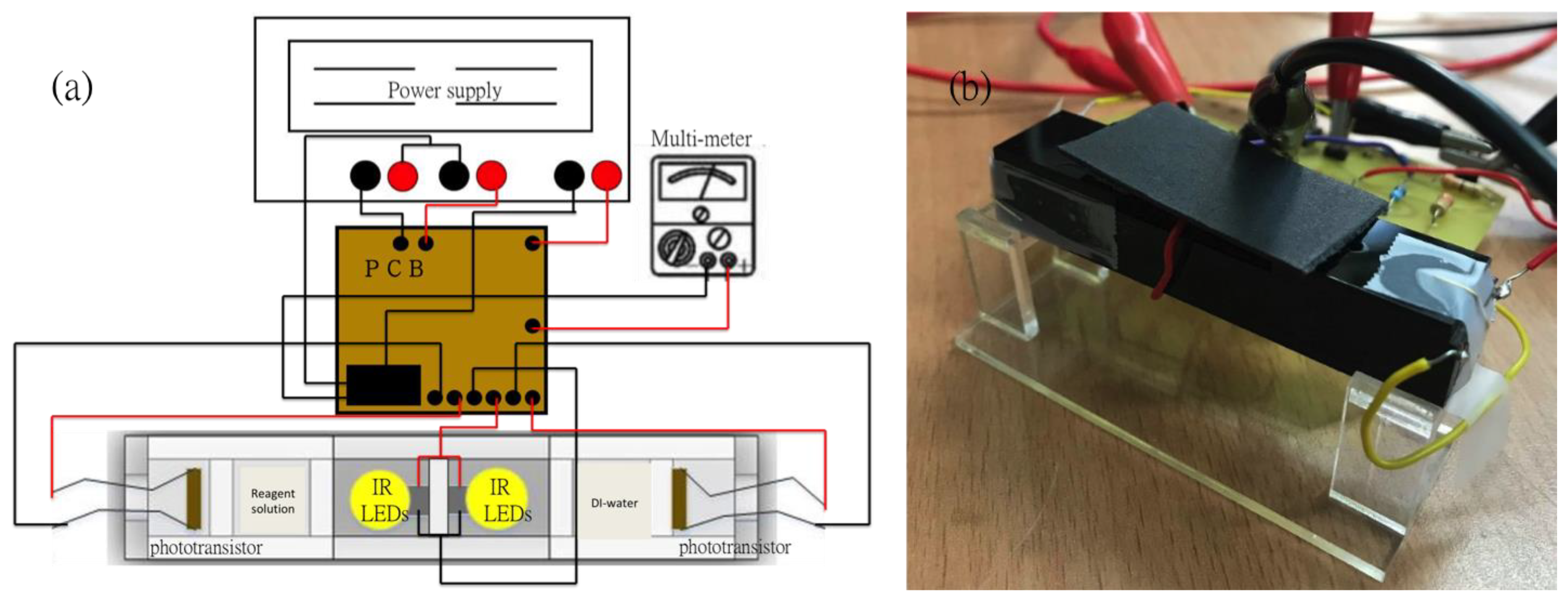


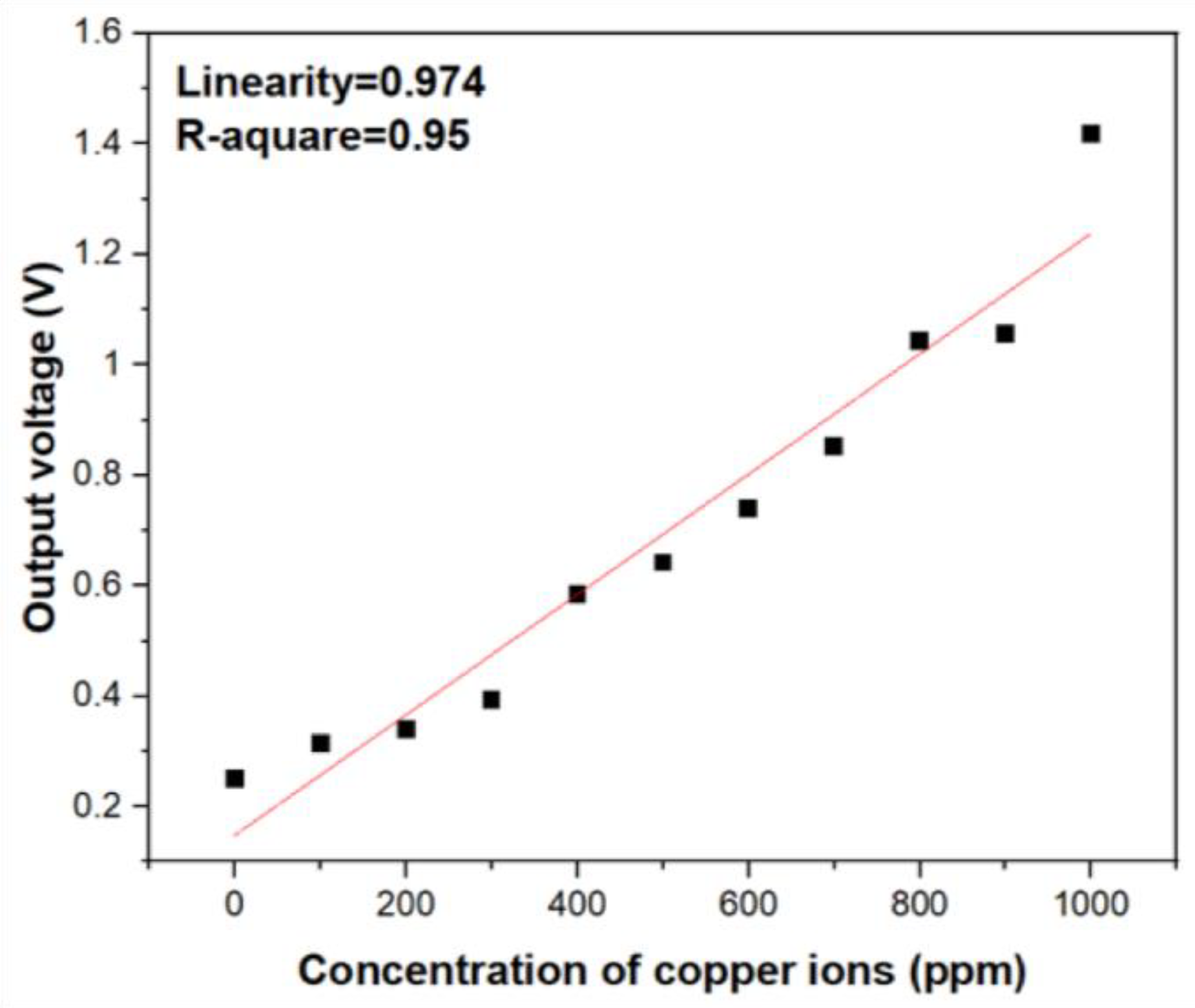
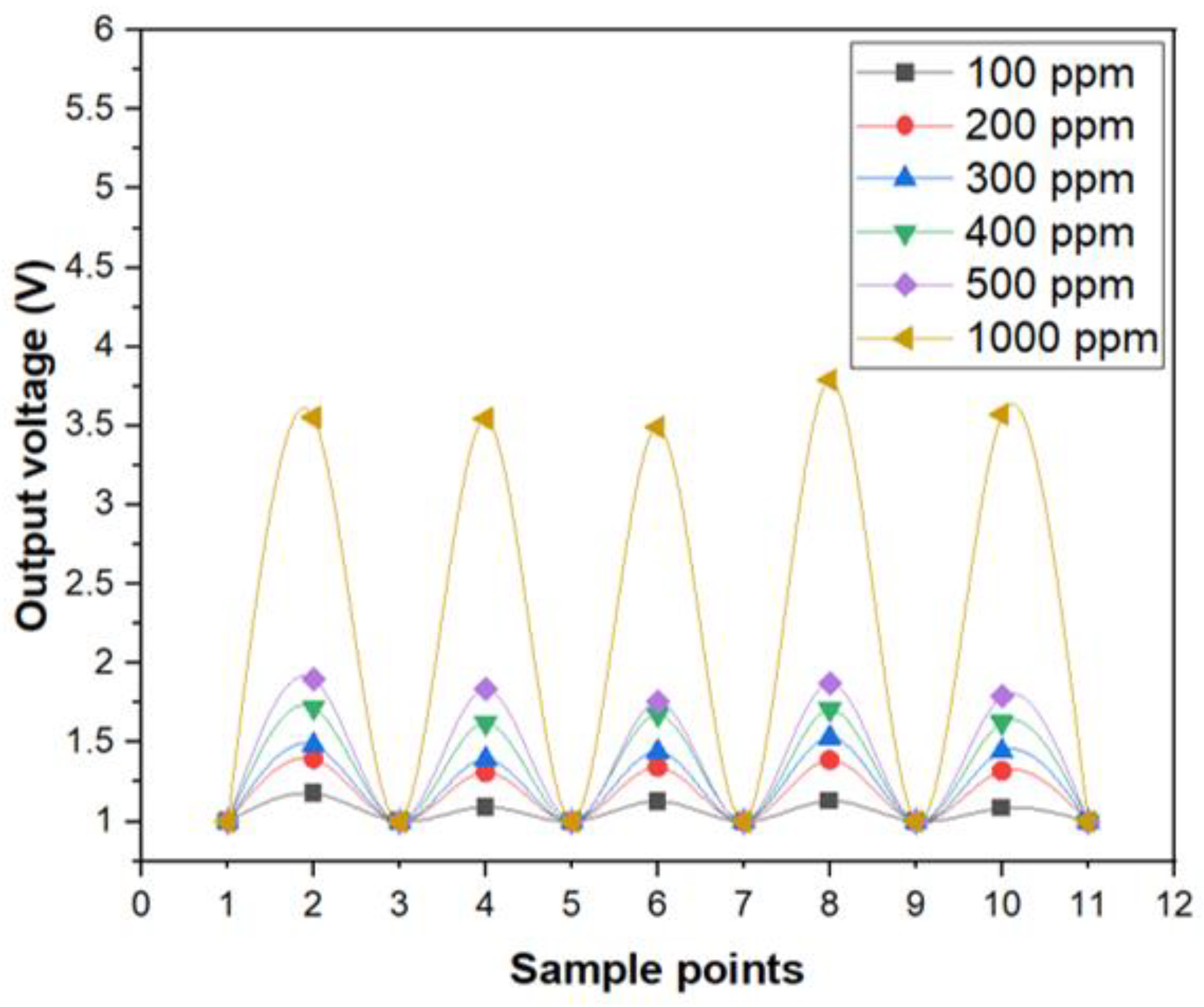
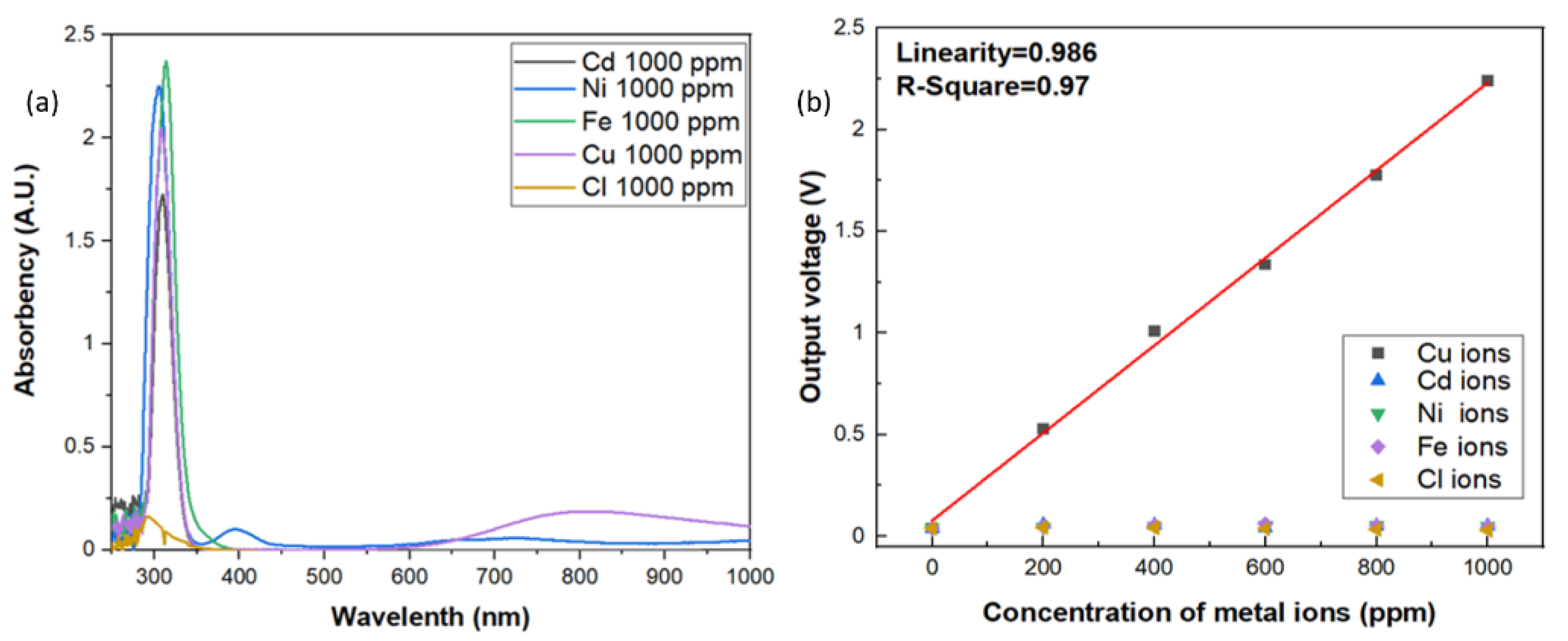
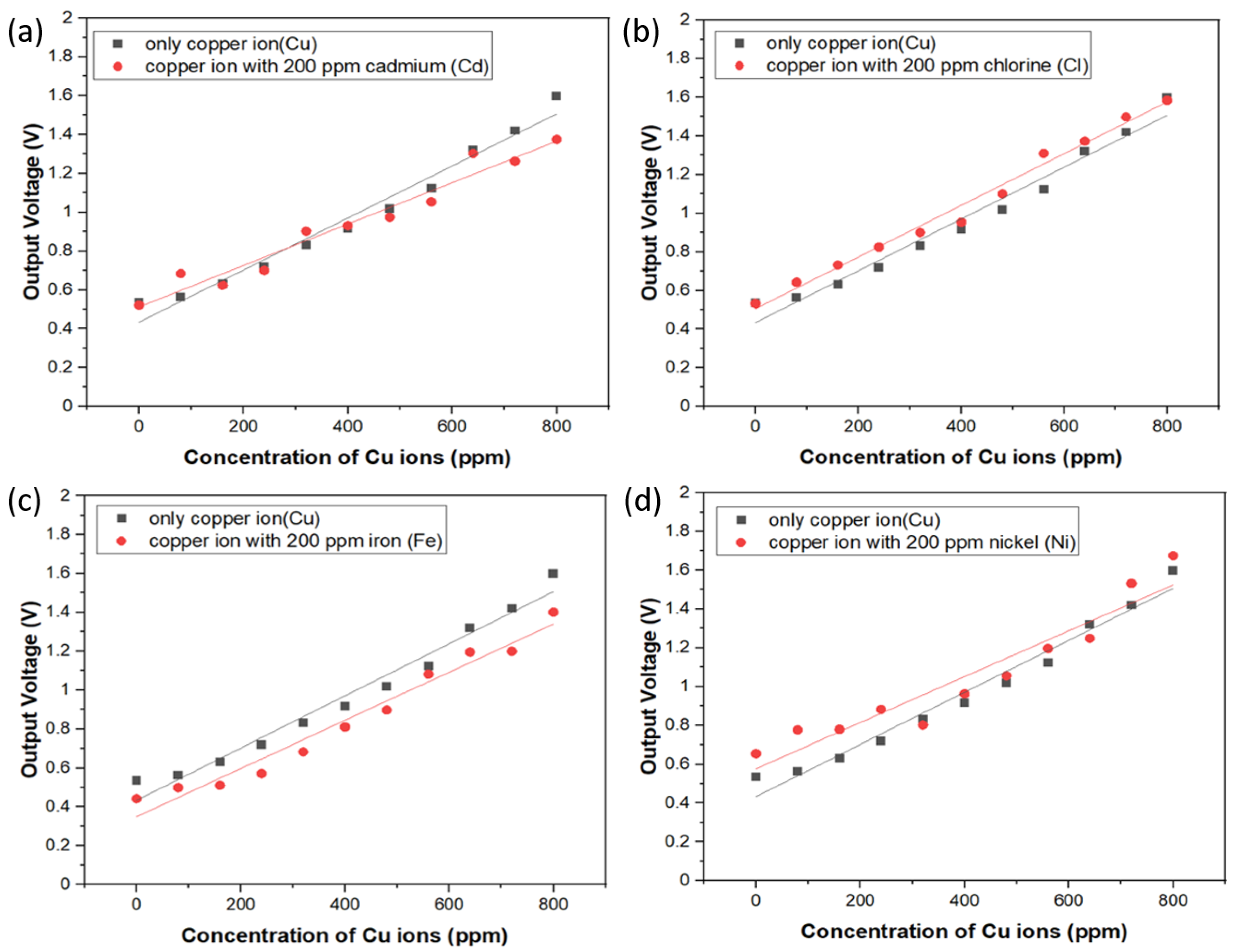
| Element | Calibration Standards | Catalogue No. |
|---|---|---|
| Cu: | 1000 | 100014-1 |
| Cd: | 1000 | 100008-1 |
| Ni: | 1000 | 100036-1 |
| Fe: | 1000 | 100026-1 |
| Cl: | Sodium chloride in water | 941708 |
| Sr. No. | Measurement Techniques | Analytical Ranges (Detection Limit) (N/A: Not Announced) | Selectivity | Response Time | Cost | Ref. |
|---|---|---|---|---|---|---|
| 1. | Fluorescent Sensors | 2.5–35 μM (1.8 μM) | Good | 8 min | N/A | [8] |
| 2. | Fluorescent Sensors | N/A (12.7 ppb) | Good | N/A | N/A | [9] |
| 3. | Fluorescent Sensors | N/A (2.32 × 10−5 M) | Good | N/A | N/A | [10] |
| 4. | colorimetric chemosensor | 280–800 nM (0.15 μM) | Good | N/A | N/A | [12] |
| 5. | fluorescence | N/A (2.3 μM) | Good | N/A | N/A | [13] |
| 6. | Colorimetric detection | N/A (0.10 μg/L) | Good | 30 min | N/A | [15] |
| 7. | Colorimetric detection | N/A (20 μM) | Good | N/A | N/A | [16] |
| 8. | Colorimetric detection | 0.03 μM | Good | 9 min | N/A | [17] |
| 9. | fluorescent chemosensor | 1.0 × 10−7~2.5 × 10−6 mol/L (2.0 × 10−8 mol/L) | Good | N/A | N/A | [18] |
| 10. | ISE and ISFET microsensors | 1.0 × 10−6 mol/L | Good | 10 s | N/A | [19] |
| 11. | Optical sensor | 1~1000 ppm | 29 mV/ppm | Less than 5 sec | Low (less than 40 USD) | This work |
Publisher’s Note: MDPI stays neutral with regard to jurisdictional claims in published maps and institutional affiliations. |
© 2021 by the authors. Licensee MDPI, Basel, Switzerland. This article is an open access article distributed under the terms and conditions of the Creative Commons Attribution (CC BY) license (http://creativecommons.org/licenses/by/4.0/).
Share and Cite
Hung, S.-C.; Lu, C.-C.; Wu, Y.-T. An Investigation on Design and Characterization of a Highly Selective LED Optical Sensor for Copper Ions in Aqueous Solutions. Sensors 2021, 21, 1099. https://doi.org/10.3390/s21041099
Hung S-C, Lu C-C, Wu Y-T. An Investigation on Design and Characterization of a Highly Selective LED Optical Sensor for Copper Ions in Aqueous Solutions. Sensors. 2021; 21(4):1099. https://doi.org/10.3390/s21041099
Chicago/Turabian StyleHung, Sheng-Chun, Chih-Cheng Lu, and Yu-Ting Wu. 2021. "An Investigation on Design and Characterization of a Highly Selective LED Optical Sensor for Copper Ions in Aqueous Solutions" Sensors 21, no. 4: 1099. https://doi.org/10.3390/s21041099
APA StyleHung, S.-C., Lu, C.-C., & Wu, Y.-T. (2021). An Investigation on Design and Characterization of a Highly Selective LED Optical Sensor for Copper Ions in Aqueous Solutions. Sensors, 21(4), 1099. https://doi.org/10.3390/s21041099






